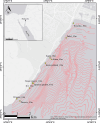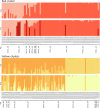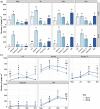Depth-structured lineages in the coral Stylophora pistillata of the Northern Red Sea
- PMID: 40188306
- PMCID: PMC11972390
- DOI: 10.1038/s44185-025-00083-9
Depth-structured lineages in the coral Stylophora pistillata of the Northern Red Sea
Abstract
Coral reefs are biodiversity hotspots, where new species continue to be discovered. Stylophora pistillata, a depth-generalist coral, is widely distributed throughout the Indo-Pacific and has long been considered the poster child for phenotypic plasticity. It occupies a wide range of reef habitats and exhibits a myriad of gross morphologies. Here, we used reduced representation genome sequencing (nextRAD) to assess the genetic structure of adults and recruits of S. pistillata across shallow and mesophotic populations in the northern Red Sea (Gulf of Aqaba). Across analytical approaches, we observed a complex genetic structure with at least four genetically divergent lineages occurring sympatrically with little to no admixture and structured by depth. Morphological and physiological differences previously documented suggest that the long-considered ecological opportunism of S. pistillata in the Red Sea may, in fact, have a genetic basis. Assessment of both adult colonies and recruits within each of the lineages also revealed the prevalence of local recruitment and genetic structuring across the eight-kilometer section of the Israeli Red Sea coastline. Overall, the observed patterns confirm the presence of undescribed diversity within this model organism for coral physiology and corroborate a broader pattern of extensive undescribed diversity within scleractinian corals.
© 2025. The Author(s).
Conflict of interest statement
Competing interests: The authors declare that they have no known competing financial interests or personal relationships that could have appeared to influence the work reported in this paper.
Figures





Similar articles
-
Molecular and skeletal fingerprints of scleractinian coral biomineralization: From the sea surface to mesophotic depths.Acta Biomater. 2021 Jan 15;120:263-276. doi: 10.1016/j.actbio.2020.01.010. Epub 2020 Jan 16. Acta Biomater. 2021. PMID: 31954936
-
Morphological stasis masks ecologically divergent coral species on tropical reefs.Curr Biol. 2021 Jun 7;31(11):2286-2298.e8. doi: 10.1016/j.cub.2021.03.028. Epub 2021 Apr 2. Curr Biol. 2021. PMID: 33811819
-
Eutrophication may compromise the resilience of the Red Sea coral Stylophora pistillata to global change.Mar Pollut Bull. 2018 Jun;131(Pt A):701-711. doi: 10.1016/j.marpolbul.2018.04.067. Epub 2018 May 10. Mar Pollut Bull. 2018. PMID: 29886997
-
Stylophora under stress: A review of research trends and impacts of stressors on a model coral species.Sci Total Environ. 2022 Apr 10;816:151639. doi: 10.1016/j.scitotenv.2021.151639. Epub 2021 Nov 13. Sci Total Environ. 2022. PMID: 34780827 Review.
-
Red Sea Atlas of Coral-Associated Bacteria Highlights Common Microbiome Members and Their Distribution across Environmental Gradients-A Systematic Review.Microorganisms. 2022 Nov 26;10(12):2340. doi: 10.3390/microorganisms10122340. Microorganisms. 2022. PMID: 36557593 Free PMC article. Review.
References
-
- Fisher, R. et al. Species richness on coral reefs and the pursuit of convergent global estimates. Curr. Biol.25, 500–505 (2015). - PubMed
-
- Reaka-Kudla, M. L. The Global biodiversity of coral reefs: A comparison with Rain Forests. In: Biodiversity II Understanding and Protecting Our Natural Resources (eds. Reaka-Kudla, M. L., Wilson, D. E. & Wilson, E. O.) 83–108 (Joseph Henry/National Academy Press, 1997).
-
- WoRMS. Scleractinia. https://www.marinespecies.org/aphia.php?p=taxdetails&id=1363 (2024).
-
- Baker, A. C., Glynn, P. W. & Riegl, B. Climate change and coral reef bleaching: An ecological assessment of long-term impacts, recovery trends and future outlook. Estuar. Coast. Shelf Sci.80, 435–471 (2008).
Grants and funding
LinkOut - more resources
Full Text Sources
Research Materials

